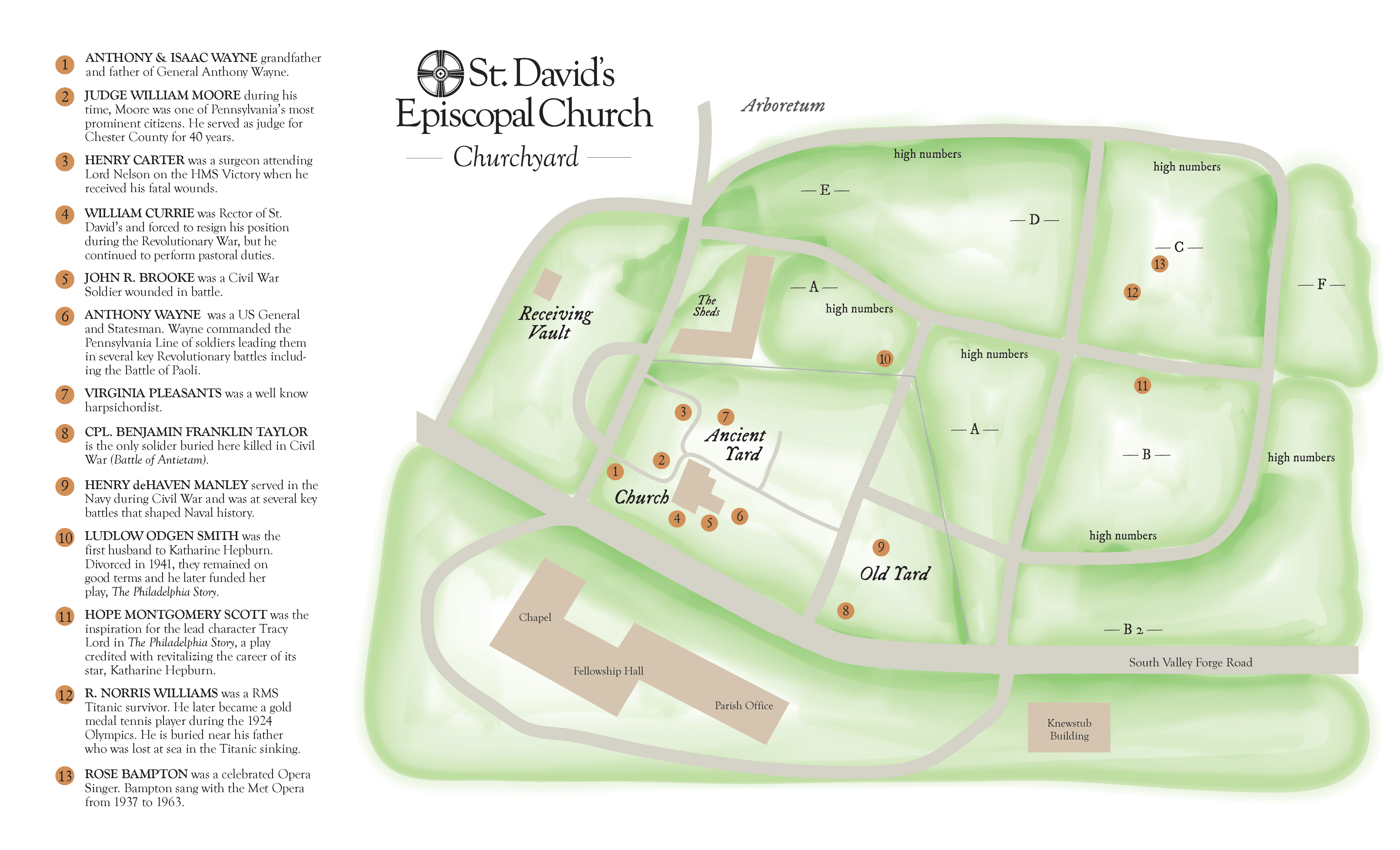Indigenous Land Acknowledgement
“We remember and honor the Indigenous people of the world, especially the Lenape, also known as the Lenni-Lenape or Delaware Indians. We acknowledge that St. David’s Church stands on the land that was once their home called the “Lenapehoking”. We acknowledge the Lenape Nation of Pennsylvania, the Lenape remaining in their homeland in New Jersey and Delaware, and the Lenape diaspora represented by nations based in Oklahoma, Wisconsin, and Ontario. We give thanks for them and express our gratitude for their witness on how to live a life that is honorable and humble. May we always remember that the Earth does not belong to us; that we belong to the Earth, and that we are all relatives in life. Help us to learn from our past and be instruments of justice and peace for all people in today’s world, particularly the original Indigenous inhabitants.”
Learn more about the Lenape Nation in Pennsylvania.
Learn more about Indigenous Ministries in The Episcopal Church.
Historic St. David’s
Today, as the largest of the 157 parishes in the Diocese of Pennsylvania, St. David’s stands on the threshold of a new era of service to the body of Jesus Christ. In 2015, as we marked the 300th Anniversary of laying the church cornerstone, we were thoughtful of the many who helped shape St. David’s and make us the church we are today.
Toward the close of the seventeenth century, a hardy group of Welsh colonists settled in an area which became known as Radnor. In 1704, a 100-signature petition for Welsh prayer books and a Bible, but more particularly for a Welsh-speaking missionary, was dispatched to the Society for the Propagation of the Gospel in London. Ten years later, in return for this long-awaited recognition, the settlers “heartily engaged themselves to build a handsome stone church,” to be named after the Patron Saint of Wales. The cornerstone was laid on May 9, 1715.
With the coming of the Revolution in the colonies, a rapidly swelling wave of resentment against the Church of England arose among the patriots of the congregation. A leader of this opposition was Anthony Wayne, later appointed major general of the American forces, who is buried in St. David’s historic churchyard. The church building provided shelter for soldiers of both sides.
St. David’s was represented at the first General Convention of the Protestant Episcopal Church of the United States in 1784. The incorporation and charter of the church followed in August of 1792. Much-needed new life was breathed into St. David’s in 1820 with the organization of the first church school and arrangements for the first confirmation services, conducted by Bishop William White, who was the first Presiding Bishop.
The opening of the “Main Line” of the Pennsylvania Railroad in 1832 brought rapid social evolution to the locale. Philadelphians who came first to summer at boarding houses and new hotels along the way, now began to buy and develop agricultural land. St. David’s acquired a new breed of urban parishioners. The first physical addition to the church holdings was the fieldstone “Old Rectory” in 1844 across Valley Forge Road, now the home for the Associate Rector.
With the passing years, the church complex has grown as the parish has grown. A parish house with church school facilities was erected in 1924 and enlarged in 1950. A heated discussion over whether the parish should accommodate a burgeoning membership or retain its early character was resolved with the construction of the chapel in 1956, adjoining the parish house, which is several times the size of the original church. The Knewstub Building for education was added in 1965, the year when the parish celebrated its 250th anniversary at a service attended by the Bishop of St. David’s in Wales.
A new wave of growth began in the late 1940s as St. David’s lived more deeply into its mission. In 2006, a new chapel, capable of accommodating 650 worshipers, was consecrated. In 2015, the church raised the roof on the 1956 chapel for a better Fellowship Hall, offices, and much-needed space for Christian education of all ages.
View the video below for a presentation by Dr. Joe Bonn about the history of research, decisions, and events that brought St. David’s the Opus 84: A Pipe Organ for the 4th Century of St. David’s Church.
St. David’s Churchyard
The St. David’s Churchyard is a place of final rest for those who are departed, as well as a place for reflection, peace and prayer for those who come to visit loved ones, and those who desire a reflective place. It is a place of deep history and is included in the National Register of Historic Places.
St. David’s Arboretum
In the late 1940’s and early 1950’s, the John Newbold Family chose to beautify an area of St. David’s Church to be used as a memorial place for parishioners. The arboretum was established along the creek with the help of many parish volunteers.
Gravesites
St. David’s graveyard has been a peaceful resting and memorial place for nearly 300 years. Several historic dignitaries, including Gen. Anthony Wayne, are buried within its walls. The Churchyard grounds welcome all who would like to stroll its stone paths or meditate among its tall trees. Gravesites are available for purchase for St. David’s parishioners only. To pre-select a plot, or to prepare for the immediate internment of a loved one, please contact the Church office. For research requests, please contact the church office during regular office hours. We would be happy to help you locate a specific site.
